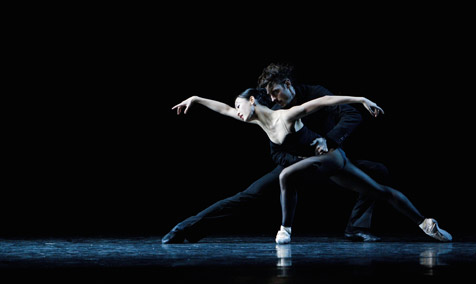A Conversation with La La La Human Steps Artistic Director douard Lock
Call It Dance

Their whimsical name may be unfamiliar to Santa Barbara dance fans, but La La La Human Steps has been one of Canada’s leading contemporary dance companies for nearly three decades. Artistic Director douard Lock has been at the helm of the company since its foundation, throughout the years developing it from a purely contemporary dance troupe to one that borrows heavily from the tradition of classical ballet. His latest work, Amjad, is a 21st-century commentary on two of the most revered Romantic ballets: Sleeping Beauty and Swan Lake. In deconstructing these works, Lock draws on their historical and psychological contexts and brings original film, new music, and innovative lighting design to bear on the choreography. Lock spoke to me over the phone from the company’s base in Montreal last week.

What was it that inspired you to use the classical ballets Sleeping Beauty and Swan Lake as your references for Amjad? It’s always interesting for me to work with memories, and these are two of the most iconic ballets in terms of the influence they’ve had over the years, and the influence of the composer. Tchaikovsky was the first composer to seriously address the ballet idiom. These ballets have penetrated society in the sense that many people have associations with the music or the theme or the visuals of these ballets without ever having seen them. When you have these kinds of deep-seated memories, it’s really interesting to create alternatives onstage.
Amjad deals with themes like the conscious and unconscious mind. How do you approach such abstract concepts through dance? These very old themes-whether they’re in ballets or fairy tales or other literary works-can be seen on a surface level, but oftentimes hide complexities. If you look at the actual structure of these ballets, they start with the castle and the introduction of all the various characters and the folk dances and all the boring stuff, but after that they go into more abstract areas, where you can see the choreographers sort of spreading their wings and exploring things that are more visually appealing and aesthetically abstract. I think those are the moments that people associate with these ballets, the ones that have penetrated society so deeply.
Amjad is very cinematic. Were you thinking about film when you made this work? I guess what you mean is the use of the lights in the production. They tend not to react to movement simply by following the mover around. They interfere or change or fluctuate in their positions even if the person is still in same part of the stage. They are film-like in the sense that they influence what you’re looking at non-functionally. They’re not simply there to light a section of the stage that’s being used, but to actually affect the way you respond visually to the person being lit.
And is that your influence, or is that the work of a lighting designer? It’s my work-it’s always been something I’ve found interesting, and I’ve pushed it over many years of production. I don’t think there’s a vast difference between film and stage in some parts of what they both offer. Editing, for instance, is essentially the eye being interested in a subject. If you’re interested in something, you tend to virtually get closer to it and shift positions around it and stutter and do all sorts of other visually complex things, but you do it so seamlessly that you probably don’t notice you’re doing it. So having that as part of my philosophy kind of pushes me in certain directions. I always thought that it was an odd thing to do-to go on a stage and present everything perfectly exposed-because it’s not what I see. Light sometimes, in my opinion, should interfere with the subject.
What kind of dancers do you look for? I think what makes a good ballet dancer or a good dancer, period, is the ability to create a bond, an empathetic bond between the audience and themselves. Showing up is no way to do it; you have to actually take an ego risk with the material you are presenting so that you are going to a place where you invite, to a certain point, failure. It can be the kind of failure that only you will know, but it creates a vulnerability and a fragility to what you’re presenting that echoes the point of view of the audience, who also have failed, on that day, on that week, on that year. I like that better than charismatic theater, where there is one group of people showing off and another group of people admiring them. That is not something that I’m attracted to. But it takes a special kind of person to initiate that. It takes a certain mental and emotional profile-it’s not something you can force on anybody.
If your work is not charismatic theater, what would you call it? I’d call it dance.
4•1•1
La La La Human Steps will perform Amjad on Tuesday, April 8, at the Granada Theatre at 8 p.m. For tickets or more information, call 893-3535 or visit artsandlectures.ucsb.edu. The company will also teach a public masterclass on Monday, April 7, from 7:30-9:30 p.m. For more information or to reserve a spot, call 966-6950 or visit sbdancealliance.org.



